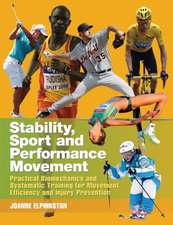Hypoxia and Exercise: Advances in Experimental Medicine and Biology, cartea 588
Editat de Robert Roach, Peter D. Wagner, Peter Hacketten Limba Engleză Hardback – 4 oct 2006
| Toate formatele și edițiile | Preț | Express |
|---|---|---|
| Paperback (1) | 1413.93 lei 6-8 săpt. | |
| Springer Us – 19 noi 2010 | 1413.93 lei 6-8 săpt. | |
| Hardback (1) | 1420.29 lei 6-8 săpt. | |
| Springer Us – 4 oct 2006 | 1420.29 lei 6-8 săpt. |
Din seria Advances in Experimental Medicine and Biology
- 9%
 Preț: 719.60 lei
Preț: 719.60 lei - 20%
 Preț: 691.93 lei
Preț: 691.93 lei - 5%
 Preț: 717.00 lei
Preț: 717.00 lei - 5%
 Preț: 716.28 lei
Preț: 716.28 lei - 5%
 Preț: 717.20 lei
Preț: 717.20 lei - 15%
 Preț: 640.24 lei
Preț: 640.24 lei - 5%
 Preț: 1113.83 lei
Preț: 1113.83 lei - 5%
 Preț: 715.71 lei
Preț: 715.71 lei - 5%
 Preț: 820.43 lei
Preț: 820.43 lei - 15%
 Preț: 641.38 lei
Preț: 641.38 lei - 5%
 Preț: 716.28 lei
Preț: 716.28 lei - 5%
 Preț: 523.99 lei
Preț: 523.99 lei - 5%
 Preț: 1031.00 lei
Preț: 1031.00 lei - 5%
 Preț: 717.00 lei
Preț: 717.00 lei - 5%
 Preț: 715.35 lei
Preț: 715.35 lei - 20%
 Preț: 1161.71 lei
Preț: 1161.71 lei - 5%
 Preț: 1170.51 lei
Preț: 1170.51 lei - 18%
 Preț: 1119.87 lei
Preț: 1119.87 lei - 5%
 Preț: 1288.48 lei
Preț: 1288.48 lei - 5%
 Preț: 1164.67 lei
Preț: 1164.67 lei - 5%
 Preț: 1101.73 lei
Preț: 1101.73 lei - 18%
 Preț: 1123.67 lei
Preț: 1123.67 lei - 5%
 Preț: 1435.64 lei
Preț: 1435.64 lei - 20%
 Preț: 1044.10 lei
Preț: 1044.10 lei - 18%
 Preț: 946.39 lei
Preț: 946.39 lei - 5%
 Preț: 292.57 lei
Preț: 292.57 lei - 18%
 Preț: 957.62 lei
Preț: 957.62 lei - 18%
 Preț: 1235.76 lei
Preț: 1235.76 lei - 5%
 Preț: 1231.55 lei
Preț: 1231.55 lei - 5%
 Preț: 1292.30 lei
Preț: 1292.30 lei - 5%
 Preț: 1102.10 lei
Preț: 1102.10 lei - 18%
 Preț: 1132.81 lei
Preț: 1132.81 lei - 5%
 Preț: 1165.19 lei
Preț: 1165.19 lei - 5%
 Preț: 1418.48 lei
Preț: 1418.48 lei - 5%
 Preț: 1305.63 lei
Preț: 1305.63 lei - 18%
 Preț: 1417.72 lei
Preț: 1417.72 lei - 18%
 Preț: 1412.99 lei
Preț: 1412.99 lei - 24%
 Preț: 806.16 lei
Preț: 806.16 lei - 18%
 Preț: 1243.29 lei
Preț: 1243.29 lei - 5%
 Preț: 1429.44 lei
Preț: 1429.44 lei - 5%
 Preț: 1618.70 lei
Preț: 1618.70 lei - 5%
 Preț: 1305.12 lei
Preț: 1305.12 lei - 18%
 Preț: 1124.92 lei
Preț: 1124.92 lei - 5%
 Preț: 1097.54 lei
Preț: 1097.54 lei - 15%
 Preț: 649.87 lei
Preț: 649.87 lei - 5%
 Preț: 1097.54 lei
Preț: 1097.54 lei - 18%
 Preț: 945.79 lei
Preț: 945.79 lei - 5%
 Preț: 1123.16 lei
Preț: 1123.16 lei
Preț: 1420.29 lei
Preț vechi: 1495.04 lei
-5% Nou
Puncte Express: 2130
Preț estimativ în valută:
271.80€ • 295.14$ • 228.32£
271.80€ • 295.14$ • 228.32£
Carte tipărită la comandă
Livrare economică 22 aprilie-06 mai
Preluare comenzi: 021 569.72.76
Specificații
ISBN-13: 9780387348162
ISBN-10: 0387348166
Pagini: 353
Ilustrații: XV, 353 p.
Dimensiuni: 155 x 235 x 25 mm
Greutate: 0.68 kg
Ediția:2007
Editura: Springer Us
Colecția Springer
Seria Advances in Experimental Medicine and Biology
Locul publicării:New York, NY, United States
ISBN-10: 0387348166
Pagini: 353
Ilustrații: XV, 353 p.
Dimensiuni: 155 x 235 x 25 mm
Greutate: 0.68 kg
Ediția:2007
Editura: Springer Us
Colecția Springer
Seria Advances in Experimental Medicine and Biology
Locul publicării:New York, NY, United States
Public țintă
ResearchCuprins
Hypoxia Honoree.- A Tribute to John Burden West.- Adventures in High-Altitude Physiology.- Exercise-Induced Hypoxemia (EIH): Causes and Consequences.- Exercise Induced Arterial Hypoxemia: The role of Ventilation-Perfusion Inequality and Pulmonary Diffusion Limitation.- Intrapulmonary Shunt During Normoxic and Hypoxic Exercise in Healthy Humans.- Exercise-Induced Arterial Hypoxemia: Consequences For Locomotor Muscle Fatigue.- Causes and Effects of Sleep-Disordered Breathing.- Mechanisms of Sleep Apnea at Altitude.- Control of Cerebral Blood Flow During Sleep and The Effects of Hypoxia.- Neural Consequences of Sleep Disordered Breathing: The Role of Intermittent Hypoxia.- Genetics, Genomics and Adaptation to High Altitude.- Finding the Genes Underlying Adaptation to Hypoxia Using Genomic Scans for Genetic Adaptation and Admixture Mapping.- An Evolutionary Model for Identifying Genetic Adaptation to High Altitude.- Hypoxic Preconditioning and Erythropoietin Protect Retinal Neurons from Degeneration.- Blocking Stress Pathways with Cell-Permeable Membranes.- Blocking Stress Signaling Pathways with Cell Permeable Peptides.- JNK Pathway as Therapeutic Target to Prevent Degeneration in the Central Nervous System.- Salvage Of Ischemic Myocardium: A Focus on JNK.- The Impact of Immobilization and Hypoxia on Skeletal Muscle.- Mitochondrial Reactive Oxygen Species are Required for Hypoxic HIF? Stabilization.- Hypoxia-Induced Gene Activity in Disused Oxidative Muscle.- Hypoxic Vasoregulation: Interactions of Red Cells, Endothelium and Smooth Muscle.- Role of the Red Blood Cell in Nitric Oxide Homeostasis and Hypoxic Vasodilation.- Expression of the Heterotrimeric G Protein Gi and ATP Release are Impaired in Erythrocytes of Humans with Diabetes Mellitus.- Red Blood Cells andHemoglobin in Hypoxic Pulmonary Vasoconstriction.- Hypoxia: State of the Art.- Dose-Response of Altitude Training: How Much Altitude is Enough?.- The Eye at Altitude.- Lake Louise Consensus Methods for Measuring the Hypoxic Ventilatory Response.- Future Directions in Hypoxia Research.- Pulmonary Hypertension in High-Altitude Dwellers: Novel Mechanisms, Unsuspected Predisposing Factors.- Gene Hunting in Hypoxia and Exercise.
Caracteristici
First comprehensive volume on hypoxia that can be marketed to physiologists, neuroscientists, anesthesiologists, cardiologists, and those involved in sports training and medicine alike Includes supplementary material: sn.pub/extras







